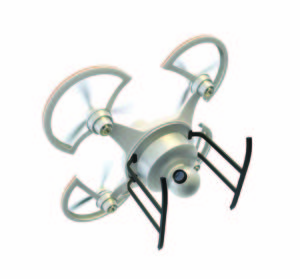Trending
Drone (n.)
December, 2017
The buzz around taking to the skies

Maybe you’ve noticed them hovering above the action at football games and outdoor concerts. Or maybe you’ve spotted them in quiet, rural areas, as they skitter noiselessly through the air. In more and more places, drones are becoming a common sight. These aircraft, also known as Unmanned Aerial Vehicles (UAVs), are proving to be useful and versatile in a wide range of fields. With that in mind, here’s what you need to know about these “flying robots.”
From Bees to Bombs
The word drone originates from Old English in reference to a male bee. After World War II, the term was borrowed to describe the pilotless aircraft that militaries were beginning to develop. And it’s easy to understand why. With their quiet engines and ability to hover, the flight of a drone resembles that of a bee. As intriguing a technology as that was, militaries were far more focused on building rockets during the Cold War, and it wasn’t until the 1970s that drones stepped into the spotlight when Israelis equipped them with cameras and advanced telecommunications, which made video-streaming and real-time reconnaissance possible. Further advancements in the 1980s and 90s made drones even more versatile—and deadly.
In the 2000s, the US began carrying out targeted strikes using drones armed with missiles. As precise as these strikes have been, they have also frequently put civilians in harm’s way.
Taking Flight
Although drones were originally developed for their military value, their commercial and recreational value have skyrocketed in significance. Civilian drones are, of course, a lot different than their warlike predecessors—but they don’t lack sophistication. Civilian drones are often quadcopters, with four rotors that can work at variable speeds. This makes it possible for the drone to move, change direction, hover and so on. And all of this is controllable from the ground, thanks to computerized controllers, sensors and software that essentially turn drones into smart machines. In fact, many civilian drones can fly autonomously using preprogrammed waypoints. As a result, many commercial drones are fairly easy to fly, even for beginners.
So what about the legal fine print? In Canada, drone use is regulated by Transport Canada. Recreational pilots with drones weighing more than 250 grams but less than 35 kilograms do not need special permission to fly. A number of rules must still be followed, though. A recreational drone must be flown within 90 metres of the ground and, depending on its size, a certain distance from vehicles and the public (see the Transport Canada website at www.tc.gc.ca for more rules). Exemptions are granted, however, if you’re flying at a sanctioned field or event. Non-recreational users—those flying drones for work or research—and pilots flying drones weighing more than 35 kilograms must obtain a Special Flight Operations Certificate.
Getting Out in the World
Drones are still primarily a military technology, but their civilian use is rapidly growing. No wonder, too, when you consider all the different uses people are finding for them. Photographers and journalists use drones to gather images and film events. Utility companies use them to inspect infrastructure, such as pipelines and transmission towers. Drones are even playing important roles in disaster management, as a tool for assessing damage, assisting search and rescue and tracking the progress of storms and forest fires. Last but pop-culturally not least, people everywhere are using hand-sized drones to snap the perfect selfie. There are still privacy and safety issues surrounding their use, but with the growing popularity of drones, chances are we’ll be seeing a lot more of them. t8n
The Highs & Lows
LiteHawk Quattro Radical
•$49.97
- Just 2.75” across
- Remote controlled
- Can perform tricks
- Rechargeable battery
- Up to 8 minutes of flight time
DJI Inspire 2
•$8,059
- Top speed of 108 kph
- Camera and image processing system
- Up to 27 minutes of flight time
- Operating range of 7 km
- Works in -20ºC
Did You Know?
According to a 2015 report by Jane’s Information Group, global investment in drone hardware will top $12 billion (US) by 2021. About $9 billion of that will come from governments, with another $2 billion from consumers and $1 billion from business and entrepreneurs.













